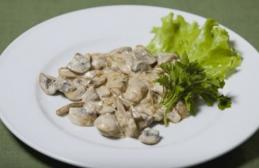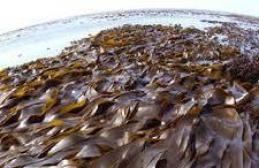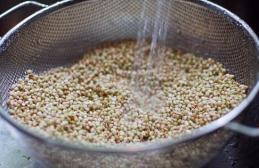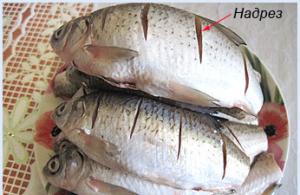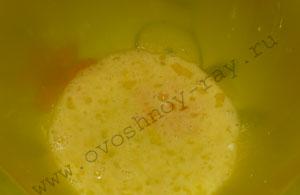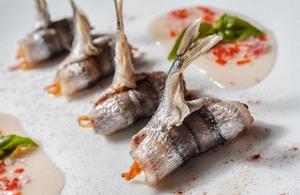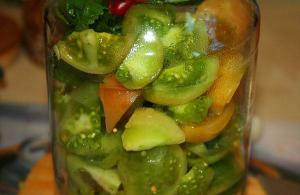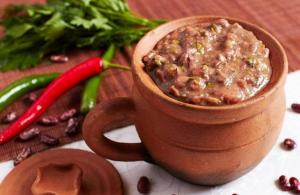Old Russian vodkas
The word “vodka” may now cause confusion. The difference between what is now sold in bottles, albeit under the same name, is most often only in the labels and in the number of unpleasant-looking stains that appear on the surface of the liquid poured into a glass. Meanwhile, today's vodka has very little in common with what has long been called vodka in Rus' and has deservedly received worldwide fame. In addition to the fact that many varieties of vodka were sold, really and significantly different from each other, in a decent house it was considered bad manners to put a store-bought bottle on the table. A real housewife always tried to give the treat a unique originality with her own hands. After all, vodka prepared at home has a taste and smell incomparable to store-bought; poured into a decanter and passed through the skillful hands of the owner, the drink evokes in guests a completely different attitude than an ordinary faceless bottle.
Before we give several recipes for homemade vodka, we will focus on methods for purifying ordinary vodka or drinking alcohol from the unpleasant odors they often have. This is not difficult to do, especially if you have a summer house or garden plot.
Take a few dry birch logs and build a fire from them. When the coals reach the highest temperature and have already crumbled, scoop them into a clay pot, blow off all the ash as cleanly as possible and tightly close the pot with a lid so that the coals go out. Then remove them from the pot, blow them again, cool and grind not too finely. Place the crushed coals in a bottle at the rate of approximately 50 g per 1 liter and fill with vodka or alcohol. Over the next 3 weeks, shake the bottle 3-4 times every day. Then let the vodka sit for another week, but do not shake it. After this, filter, pour into a clean bottle, put in it very carefully sorted and as large as possible raisins 30-40 g per 1 liter and 3-4 g of orris root, finely chopped into pieces. Let the vodka sit for another 12 days and filter again. The finished drink must be completely free of foreign odors and tastes. Just keep in mind that if you insist and then dilute it, be sure to use boiled water, otherwise the mixture will become cloudy and turn white. Next, you can optionally give the vodka a color that is more pleasing to you. It’s very simple: infuse blue vodka with cornflowers, yellow with sage, green with mint, purple with sunflower seeds, brown with pine nut shells.
You can vary the density and richness of the shades to your own taste depending on the number of plants and infusion time.
To prepare vodka, you can use the following recipes, compiled back in the days when there were no difficulties with spices and spices, as well as with other products: Use direct distillation apparatus. But nothing bad will happen if you can’t get one or two ingredients for a recipe. The main thing is to keep the principle, and the drink will still turn out much better than usual.
Moscow white vintage vodka
40 g ginger, 40 g galangal, 40 g sage, 40 g mint, 40 g anise, pour 1 liter of alcohol and leave for 18 days. Then add 1.5 liters of cold raw water to the infusion (if you have spring water nearby, it’s best) and distill it all together through the apparatus. If you use vodka instead of alcohol, you can not dilute it with water or dilute it quite a bit.
Vodka "Erofeich"
35 g of mint, 35 g of anise, 35 g of coarsely crushed orange nuts, pour 1 liter of vodka purified on birch coals and leave in a warm place for 12 days. After this, the vodka can be consumed without draining the grounds, but, in principle, the grounds can be used again. pour half a portion of vodka and leave in a warm place for a month.
Vodka with almond flavor
Take the youngest shoots of the rowan tree, peel them, and cut the white stems into pieces as small as possible. Pour these pieces with the simplest wine, preferably strong white, in a volume ratio of 1:4 (1 part shoots and 4 wines) and distill. If you find the almond scent weak, add more shoots to suit your taste and distill again.
Early ripening caraway vodka
Pour 350-400 g of cumin into 1 liter of vodka and distill through a distillation apparatus. The resulting caraway water can be stored at a low temperature in the refrigerator or on an icebox in the cellar for several months. When you need caraway vodka, sweeten the water just a little, pour it into the vodka to taste, and the drink is ready.
Vodka casserole
In the simplest vodka, put from 1/10 to 1/5 of the volume of dry lemon peels, let it sit for at least a few hours and distill it all together through a distillation apparatus. Take a bottle made of the thickest glass possible and add 6 g of cinnamon, 1 g of cardamom, nutmeg to 1 liter of distilled vodka, crush all this finely beforehand. Seal the bottle and coat it with steep rye dough three fingers thick. If you are making a drink in the country and you have a stove, put it in it when it starts to cool. Repeat this for 4 days in a row. If you don’t have an oven, then use a cooling oven, but put the bottle in it at least 8 times. After preparing, filter the vodka and sweeten it slightly, but put no more than 250 g of sugar per 1 liter of vodka.
Rowan foam
Take about 1 kg of mature rowan, but ensure that it is collected before frost and crush it with a wooden pestle in a mortar. Transfer to a bottle, pour in 10-12 liters of fresh bread kvass and add 50-70 g of yeast. Leave the kvass to ferment in a room at 16°. When fermentation is almost over, which you can determine by the cessation of active gas evolution, mix the whole mass together with rowan, pour into a flask of a distillation unit and distill several times, achieving such a state of the drink that it does not have any unpleasant odors.
All of the described vodkas can be stored in well-sealed bottles for almost an unlimited time without losing taste and aroma, and even vice versa, acquiring a special nobility over the years.
Potato vodka
Taking 50 pounds (approximately 20.5 kg - the following are modern weights) of potatoes, wash them as clean as possible and grate them together with the skin. Grind 8-9 kg of ground malt in a small amount of hot boiling water and knead as best as possible. Place mashed potatoes into this solution, knead some more, leave the mixture alone for a while, then cool until the warmness of fresh milk and start with yeast. At the end of fermentation, pour the mash into a cube and distill in the usual way, through which you will get good vodka.
Carrot vodka
After washing the carrots as best as possible, boil them, then pound them together with the broth in a trough or mortar into a jelly-like consistency. Meanwhile, taking an arbitrary amount of ground barley or wheat flour, grind it in a vat of hot water, put carrot grounds there and knead in the best possible way. Once the batch is at the proper level of warmth, start it with yeast and leave it to ferment. Finally, when fermentation is complete, pour the mash into a cube, build a low fire and distill. It’s not a bad idea to put a little anise in the cube.
Pumpkin vodka
Cut the pumpkins into fairly small pieces, first remove seeds and skin. Then add 1 part water to 2 parts of the cut pumpkin and cook until the pieces are easily crushed. Pound this crumbly into a uniform thicket, which you rub with ground egg malt, adding 1.2 kg of malt to a bucket of pumpkin grounds, or 8 kg of it. To do this, put the malt in a vat, pour hot water, leave it covered for half an hour, knead it thoroughly, and then stir in the pumpkin grounds and knead until not a single lump remains. Finally, add cold water, cool the brew to the level of fresh milk, start with yeast, let it ferment, pour the mash into a still and distill as usual.
Beetroot vodka
After washing the beets as cleanly as possible, grate them on a coarse grater or chop them as finely as possible. Against the measure of chopped or crushed beets, take 6-8 parts of ground barley malt, mash in hot water, knead, let stand covered for a while. Then stir in the beets, also steamed with hot water, knead thoroughly, dilute with hot water. When the shutter has cooled to the temperature of fresh milk, start it with yeast. When the mash is ripe, pour it into a cube and distill it. To flavor the taste, you can put a little charcoal powder and anise into the cube.
Pea vodka
Commonly produced. The difference is that peas alone cannot produce vodka and therefore it is necessary to add some grains to it. It’s not bad to put barley malt or, better yet, oat malt into the brew.
Apple vodka
Crush or crush the apples to a uniform consistency, pour hot boiling water over them and cool until the warmth of fresh milk. Start this batch with yeast, cover the vat and leave to ferment. At the end of fermentation, pour the mash into a cube and distill.
Vodka from pears
After washing the pears as cleanly as possible, grind or crush them into a rather thick paste. Place it in a vat, fill it with boiling water, mash it and dilute it with as much water as is needed to fill the vat and bring the shutter itself to the warmth of fresh milk. Finally, start with the yeast. Let this brew ferment for 2-3 days, and then pour the mash into a cube and proceed as usual.
Vodka from plums
Having filled a whole tub with plums, there is no need to crush or crush them, leave them lying in the tub until, having become bloated, they settle by themselves. If there are not so many drains that you can soon collect them for a whole tub, place the containers in the cellar, in dry sand until they are gradually filled. If the plums are consumed immediately, place the covered tub in a warm place, where fermentation will occur after 2-3 weeks. The degree of sufficient fermentation of plums is known by the fact that they become dry and emit a wine-like smell. Then put them in the cube, but not to the top, and proceed according to the usual method of distillation.
The easiest way to purify distilled vodka
Place a bag of sifted beech or oak ash into a cube filled with mash; or put two large onions, two pieces of stale bread and a piece of horseradish into a cube and distill, which gives the product a very pleasant taste.
Lemon vodka
Take 800 g of lemon peel and the same amount of violet, pour 20 liters of ordinary vodka into them, leave for 5-6 days, and then distill quietly until you get 10 liters of good vodka, which, if you wish, can be sweetened with sugar.
Similar culinary recipes
To prepare vodka, you will need a quarter of a bucket of alcohol (vodka), add 100 g of coarsely crushed red pepper, then put it in a warm place for two weeks, strain, mix with syrup (1 kg of sugar per liter of water), then strain.
Rowan foam
Grind a kilogram of rowan, collected before frost, in a mortar, pour into a bottle, then add 10 liters of fresh kvass, 70 g of yeast. Place the kvass in a warm place to ferment until fermentation stops (with a water seal), distill through the apparatus three times.
Vodka casserole
Add a fifth of lemon peels to vodka, let it brew in a warm place for 4 hours and distill. Pour the resulting distillation into a thick glass bottle with a narrow neck, add 6 grams of cinnamon, 1 g of cardamom, and nutmeg (finely crushed) to each liter. Seal the vessel, cover the neck with 7 cm thick rye dough and place in a warm place for 5 days. Then filter and add sugar as desired (250 g per liter).
Raspberry vodka
Pour the raspberries into a bottle, pour strong vodka into it, or alcohol, put it in the sun for three days, then drain. Prepare hot syrup (600 g of sugar per 750 ml of water), pour it into alcohol. Pass through a filter (you can use cotton wool with crushed coal), place in a warm place for three weeks, bottle.
Ratafia berry three-varietal
Grind 2.5 kg of cherries, 600 g of currants and 600 g of raspberries. Let it sit for 6 hours, then press out the juice and add one to one vodka. For every 400 ml of the mixture, add 100 g of sugar, wait until it is completely dissolved, then for every 400 ml add 4 g of crushed bitter almonds, 1 g of cinnamon and 1 g of cloves. Stir the mixture and pour it into a bottle, leave it in the sun for 6 weeks, tightly capping it. Every 2 days, do not forget to shake the drink, then bottle it and store it like white wine.
New from users
I once knitted mats of reeds in the fall to cover grapes. And a gardener passing by asked if I was afraid that...

It’s easy to collect two harvests a year in Russia
Experienced gardeners are convinced that it is profitable to keep a vegetable garden only if you harvest two crops a year. This can be achieved...

It seems like you are taking care of the garden and adding fertilizers, but the harvest could have been larger: larger tomatoes, herring stalks...
Most popular on the site

Hello! A stray cat has taken up residence in a suburban area. M...
06.25.2019 / Veterinarian

01/18/2017 / Veterinarian

“Dead” is, of course, very cruel. But how does she...
07.06.2019 / People's Reporter

BUSINESS PLAN for breeding chinchillas from Pl...
In modern economic conditions and the market as a whole, to start a business...
12/01/2015 / Veterinarian

Grapes In the vineyard, it is finally possible to carry out protective spraying...
21.06.2019 / People's Reporter

Every gardener tries to get as much harvest as possible, and pepper here...
08.06.2019 / People's Reporter

Ingredients: red bell pepper - 2 kg;
hot pepper...

06/25/2019 / Cooking deliciously
25.06.2019 / People's Reporter

I once knitted mats of reeds in the fall to cover grapes. And while passing...
22.06.2019 / People's Reporter

Without pinching, tomatoes grow small fruits. Stepsons are removed...
If you compare people who sleep completely naked under the covers and those...

11/19/2016 / Health
Magic mixture for expelling aphids from...
26.05.2019 / People's Reporter

All sorts of sucking and gnawing creatures on the site are not our comrades. You need to part with them...
Let's get acquainted with the wonderful old recipes for vodkas and liqueurs, because many of them can be used in our time, surprising guests with the unusual tastes of holiday drinks.
Ivovka
8 glasses of quince juice, 8 glasses of vodka, a bunch of rye straw, 50 g each of sugar and vanilla sugar.
Chop a bunch of straw very finely and grate the overripe quince. Squeeze the juice out of this mixture. Mix the resulting juice with vodka. Add regular and vanilla sugar. Pour into a bottle and leave for a week. Filter.

Anisette vodka
Take 65 g of anise and 30 g of fennel, mix and grind, then take two-thirds of the resulting mixture, pour in 2 liters of vodka and 400 g of water, distill, preventing the whitish alcohol from getting into the resulting vodka. Put the remaining spices, leave for several days, sweeten with sugar dissolved in cold water (600 g per 3 l), filter.

Orange tincture
2 liters of vodka, 1 liter of water, sugar, 4-5 orange peels.
Boil syrup from refined sugar and 1 liter of water. Mix with vodka. Pour into a bottle and add orange peels. Place in the shade for 3-4 days. Filter and bottle.

Lingonberry-cherry liqueur
150 g cognac, 2 l vodka, 3.5 kg lingonberries, 600 g cherries, 2.5 l sugar syrup, citric acid.
Place all ingredients in a glass container, close tightly and leave. Filter the finished tincture and bottle it.

For 1/4 bucket of alcohol, 4 cups of water, 6 spools of cloves, one spool of white cinnamon, 1/2 spool of lemon zest, 650 g of sugar.
(1 spool = 4.266 grams)
Wash the cloves and cinnamon thoroughly, dry, crush coarsely, and add to alcohol. After 2-3 weeks, clean the tincture and strain it.
"Erofeich"

Put 410 g of English mint, 410 g of anise, 410 g of coarsely crushed hazelnuts on a bucket of purified vodka, put all this in a large bottle for 12 days in a warm place. After this, you can consume it, draining the grounds or without draining, as you wish; You can again pour half a portion of vodka onto the grounds and put it in a warm place for a month.
Casserole

1 liter of homemade vodka, 10 g ginger, 10 g hot pepper, 5 g cloves, 5 g cinnamon, 10 g lemon zest, 5 g nutmeg, 5 g cardamom.
Mix all the ingredients in a saucepan, cover with a lid, which is tightly tied to the ears of the saucepan, coat with unleavened dough so that air does not pass through, put some weight on top and put in the oven or hot oven for 12 hours. After this, cool the pan, pour the casserole into bottles and seal with stoppers.
Needle

1 liter of vodka, 1 glass of pine cones, 80 g of caramel or sugar.
Pour vodka over young pine cones, immature, soft, green in color and leave for 2 weeks. Drain the infusion and squeeze out. Sweeten with sugar or caramel (burnt sugar).
Cranberry tincture

0.5 liters of vodka, a glass of cranberries, sugar to taste.
Crush the cranberries, mix with sugar, add vodka and keep in a sealed container for a week. Then squeeze the cranberry skins through cheesecloth.
Cinnamon vodka

Grind 32 g of cinnamon very finely, put it in a cube and pour in 2 liters of vodka and a small amount of water. Distill over moderate heat until all the flavor is released. Sweeten with sugar dissolved in cold water - 600 g per 2 liters of water.
Coffee vodka

Boil 1.5 kg of sugar in water, skimming off the foam. Pour 400 g of roasted ground coffee into this syrup and let it sour. Distill, add another 200 g of coffee and let stand in a tightly sealed container for several days. Distill. Vodka is made from chocolate in the same way.
Gooseberry tincture

1 liter of vodka, 1 liter of boiled water, 1 kg of gooseberries, sugar.
Pour vodka and boiled water over the gooseberries. Keep, stirring, in the sun for 2 weeks until the gooseberries float to the surface. Strain and add sugar to taste. Leave it in the sun again, then put it in the refrigerator for 10 days. Strain again, bottle and store in a cool place. Use after 3 weeks.
Lemon vodka

1 bottle of vodka, 2 medium-sized lemons.
Cut off all the yellow skin, trying to do it as thinly as possible, since the slightest presence of white skin gives the vodka an unpleasant, bitter taste. Leave for several days in a warm place, then filter the vodka in the usual way.
Lemon vodka (option 2)

Take one lemon and a piece of sugar, grate the lemon peel. Scrape the yellowed sugar onto a plate. In this way, remove all the peel from the lemon. Add yellow sugar to vodka to taste.
Raspberry vodka

Pour mature, sorted raspberries with well-purified alcohol so that the berries are barely covered, and place in the sun. After 2-3 days, drain the alcohol.
For 4.1 liters of alcohol, take 3 glasses of water and 600 g of sugar. Boil water with sugar three times, skimming each time, and pour the raspberry-infused alcohol into the hot syrup (just enough for your finger to tolerate), little by little, stirring with a spoon.
Strain through flannel, on which you first place cotton wool, then coals, then another layer of flannel. Carefully seal the bottles of vodka and place in a warm place.
If you need to clarify vodka, then take 10-15 g of potassium permanganate for a quarter of a bucket of vodka (4.1 liters), dissolve it in a small amount of water and pour into the vodka, stirring quickly. The vodka will clear within 2-3 days; all that remains is to carefully drain and strain.
Lightly salted vodka

In the ridge where cucumbers grow, place a bottle or jar so that the cucumber will continue to grow inside that container. To do this, the ovary must be carefully pushed into the neck of the bottle or jar. When the cucumber grows, pinch it off the stem and pour good strong moonshine over it. The taste of vodka is the taste of lightly salted cucumber. If you pour store-bought vodka, you get the taste of a fresh cucumber.
Tangerine vodka

1 bottle of vodka, 2 medium-sized tangerines
Peel the tangerines and put them in vodka. Infuse in a warm place, then filter in the usual way.
Tangerine tincture

0.75 l of vodka, 6 tablespoons of dried tangerine peel. Grind the peel, add vodka and leave for a week. Refrigerate before use.
Juniper vodka

Crush 600 g of juniper berries as finely as possible and pour in 6 liters of vodka. Leave for several days, distill over very low heat. The first 2.5 liters of vodka will be the best.
Juniper vodka (option 2)

Dissolve 1.6 liters of juniper berries in alcohol and mix with 12.3 liters of vodka.
Muscat vodka

17 g nutmeg, 2 liters of vodka.
Place the nuts in the vodka, seal tightly, and leave for a while.
Mint vodka

800 g of mint, a handful of salt and 1.2 kg of honey pour 12.3 liters of vodka.
Leave for 2-3 days and distill.
Autumn tincture

500 g of rowan, 1 kg of fragrant ripe apples (ranet), 300 g of sugar, 1.5 liters of vodka.
Rowan berries collected after frost should be thoroughly washed and dried. Cut the apples into rings, after removing the core. Place rowan berries and apples in layers, sprinkling each with sugar, and pour in vodka so that the fruits are completely covered. Cover with gauze and leave to stand at room temperature for 2-3 months until the berries discolor. Filter the tincture, bottle it and store it in a dark and cool place.
Aspen tincture

Pour 300 g of aspen buds into 1 liter of vodka.
In a week the tincture will be ready. When using, add 1 tablespoon of honey.
Hunting tincture

30-40 g juniper berries, 2 g ground black pepper, 50 g dill seeds, 10-12 g table salt, 40 g horseradish.
Pour all ingredients into 1 liter of strong vodka. Leave for 2 weeks in a warm place, shaking the contents occasionally. Then strain and filter.
Foam vodka

Infuse 1 liter of vodka on a handful of juniper berries for two weeks, then on the peels of two lemons for 5 days. Mix a spoonful of crushed ginger with sugar and dilute it in infused vodka. Keep in the sun for two weeks. Strain, pour, store refrigerated. Drink in six months.
Pepper vodka

Infuse 0.7 liters of vodka with 25.6 g of black pepper beans for 2 weeks.
Pepper tincture

Infuse 2 liters of vodka with 70 g of pepper for 2 weeks, strain and dilute with weak syrup (200-300 g of sugar, 3-4 glasses of water). Leave in a warm place for several weeks, then carefully strain and bottle.
Wormwood double vodka

Pour 300 g of wormwood tops into 12 liters of plain vodka, add a handful of salt and leave for a week. After this, add 1.2 kg of honey and distill.
Wormwood tincture

Fill a 0.25-capacity bottle with fresh wormwood, add vodka and leave for 2-3 weeks. If the tincture is prepared from dried herbs, take 100 g per 1.5 liter. You can add lemon zest for flavor.
Festive vodka

For 1 liter of homemade vodka, take 1 teaspoon of soda and 1 teaspoon of citric acid, stir well.
Fisherman's tincture

For 1 liter of purified vodka 40-42%, take 3-4 cloves of garlic, finely chop and add 1.5-2 g of ground pepper, 10 g of table salt, 4-5 g of crushed bay leaves and 30 g of sugar. Leave for 4-5 days, shaking the contents daily. Then filter through a cloth filter.
Rowan vodka

Grind the ripe rowan berries in a mortar, put them in a tub until half full, add hot water, wrap the tub and tie it tightly so that the spirit does not escape, and keep it this way for twelve days, and when the rowan sours and the top of the tub becomes covered with thick stuff, like a wine mash, then take the mass from the tub with the grounds and distill it through the cube like mash, and in the fourth distillation there will be very good vodka.
French liqueur

Take a mixture of the following fragrant herbs: cardamom, galangal, ginger, cloves, cinnamon, anise at the rate of 43 g per quarter bottle of vodka.
Tea vodka

1 liter of vodka, 4 tablespoons of tea, 50-70 g of caramel.
Infuse black long tea in vodka for 3 hours, strain. Then fry the sugar in a frying pan until caramel forms, chop, add to vodka.
Rosehip vodka

Boil 800 g of rose hips in honey for an hour, strain through a sieve. Pour in 12.3 liters of 40% alcohol. Let it sit and bottle it. This vodka is extremely aromatic and tasty.
Elixir vodka

100 g cinnamon, 30 g each cloves, dill seeds, anise, cumin, 20 g each lavender and rosemary flowers, 800 g each lemon and orange peel, 2 handfuls each of thyme, oregano, mint, sage, 15 g galangal, 12 g each ginger, nutmeg, nutmeg flowers, 8 g cardamom, 12 g each angelica, calamus root, 4 g saffron.
Crush all the spices, pour in 12.3 vodka, leave for a week, distill and sweeten to taste.
I must admit that now even the word “vodka” itself in the plural causes bewilderment. The difference between what is now sold in bottles, albeit under different names, is most often only in the price and the number of unpleasant-looking stains that appear on the surface of the liquid poured into a glass.
Meanwhile, today's vodka has very little in common with what has long been called vodka in Rus' and has deservedly received worldwide fame. In addition to the fact that many varieties of vodka were sold, significantly different from each other, in a decent house it was considered bad manners to put a store-bought bottle on the table. A real housewife always tried to give the treat a unique originality with her own hands. Vodka prepared at home has a taste and smell incomparable to store-bought.
But before we give several recipes for homemade vodka, we’ll tell you how you can clean ordinary vodka from unpleasant odors and impurities. This is not difficult to do, especially if you have a summer house or garden plot.
Take a few dry birch logs and build a fire from them. When the coals reach the highest temperature and are already crumbling, put them in a clay pot with a scoop, blow off all the ash and close the lid tightly to extinguish. Remove from the pot, blow again, cool and grind, but not too finely. Place in a bottle at the rate of 50 g per 1 liter and fill with vodka or alcohol. Shake the bottle 3-4 times every day for 3 weeks. Then let the vodka sit for another week. After this, filter, pour into a clean bottle, put in it carefully sorted and as large as possible raisins 30-40 g per 1 liter and 3-4 g of orris root, finely chopped. Let the vodka sit for 12 days and filter. If you infuse alcohol and then dilute it, be sure to use boiled water, otherwise the mixture will become cloudy and turn white.
List of flowers and their corresponding plants:
- blue vodka is infused with cornflowers;
- yellow - on saffron;
- green - mint;
- red - on blueberries;
- purple - on sunflower seeds;
- brown - on the shell of pine nuts.
The saturation of the shade can be obtained depending on the number of plants and infusion time.
White Moscow vintage vodka
40 g ginger, 40 g galangal, 40 g sage, 40 g mint, 40 g anise, pour 1 liter of alcohol and leave for 18 days. Then add 1.5 liters of raw water, preferably spring water, to the infusion, and distill it all together through a distillation apparatus. If you use vodka instead of alcohol, you don’t have to dilute it with water or dilute it quite a bit.
Vintage vodka "Erofeich"
35 g of mint, 35 g of anise, 35 g of coarsely crushed orange nuts, pour 1 liter of vodka purified on birch coals and leave in a warm place for 12 days. After this, the vodka can be consumed without draining the grounds. But the grounds can be used again by filling it with half a portion of vodka and placing it in a warm place for a month.
Vodka with almond flavor
Take the youngest shoots of the rowan tree, peel and cut the white stems as small as possible. Fill them with the simplest wine, but preferably white and strong, in a ratio of 1:4 (1 part shoots and 4 wines) and distill through a distillation apparatus. If you find the almond scent weak, add the shoots and distill again.
Early ripening caraway vodka
Pour 350 g of cumin into 1 liter of water and distill through a distillation apparatus. The resulting cumin water can be stored in the refrigerator for several months. When you need cumin vodka, sweeten the water just a little, pour it into the vodka to taste, and the drink is ready.
Vodka casserole
In the simplest vodka, put from 1/10 to 1/5 of the volume of dry lemon peels, let it sit for a while (several hours) and distill everything together through a distillation apparatus. Take a thick glass bottle and add 6 g of cinnamon, 1 g of cardamom, finely crushed nutmeg to 1 liter of distilled vodka. Seal the bottle and coat with steep rye dough 3 fingers thick.
If you are preparing a drink in the country and you have a stove, then as soon as it starts to cool down, put the bottle in it overnight until the morning. Repeat this 4 times. If you don’t have an oven, then use a cooling oven, but then you need to put the bottle in it at least 8 times. After cooking, filter the vodka, you can sweeten it slightly, but not more than 250 g of sugar per 1 liter of vodka.
Rowan foam
Take about 1 kg of mature rowan, collected before frost, and crush in a mortar. Transfer to a bottle, pour in 10-12 liters of fresh bread kvass and add 50-70 g of yeast. Leave the kvass to ferment at a temperature of 16 degrees. When the fermentation is almost over, which you can determine by the cessation of active gas evolution, pour the entire mass along with the mountain ash, stirring, into the flask of a distillation unit and distill several times, achieving a state of the drink in which it does not have any foreign odor.
All of the described vodkas can be stored in well-sealed bottles for an almost unlimited time without losing taste and aroma, and even acquiring a special nobility over the years.
Good vodka, especially melon vodka, is a sip of pleasure for true connoisseurs of alcohol. The strong drink has a wonderful aroma, pleasant softness and occupies one of the first places... Continue →
11 01 2018Vodka with blackcurrant: homemade recipes
Currants are simply a storehouse of various vitamins and microelements. In addition, these berries have a fairly sweet and moderately sour taste. Excellent taste, as well as... Next →
21 12 2017Vodka from jam: homemade recipes
Moonshine is a specific drink and not everyone can drink it. However, craftsmen use it to make whiskey and cognac, tinctures and liqueurs. And you can make homemade vodka yourself using... Next →
19 12 2017Orange vodka: recipes for aromatic drinks
Citrus fruits complement alcohol well, making its taste more pleasant and lighter, which is why they are often included in many alcoholic drinks. Several recipes are known... Next →
22 11 2017Vodka on the pulp and rinds of watermelon
Watermelon vodka is a delicious aromatic drink that can be prepared according to several recipes. This is a good alcohol option for a fun company. Check out the step-by-step description... Next →
15 11 2017Recipes for aromatic pear vodka
Pear vodka turns out aromatic and tasty. It will be a good addition to any feast. You can prepare this homemade alcoholic drink using several recipes. Recipe... Next →
14 11 2017Vodka made with rowan fruits
The fruits of red rowan are widely used in folk medicine and cooking. There are many recipes for making vodka with rowan at home. No matter what... Next →
13 11 2017Ancient recipes for Russian vodka: the best options
Vodka, which was prepared by the Russian people many years ago, is significantly different from modern alcohol. Ancient recipes for Russian vodka are still available, with their help you can taste... Next →
31 10 2017Vodka infused with horseradish: the best recipes
Horseradish root is widely used for culinary purposes as a seasoning. In addition, this product is the basis of such an alcoholic product as horseradish, or vodka with horseradish. Among the people... Next →
23 10 2017Apricot vodka: recipes
Apricot vodka will be a good addition to the feast. In addition to the fact that this alcoholic drink has a pleasant taste and aroma, it is also enriched with many useful substances. For... Next →
18 10 2017Recipes for wine and vodka drinks
Wine and vodka go well with most components of mixed drinks. Cognac, rum, etc. are also used to prepare refreshing drinks. To prepare this drink from... Next →
31 05 2017Homemade raspberry vodka recipes
Many people prefer not pure vodka, but one made with berries and fruits, because such a drink has not only a pleasant taste, but also an aroma. There are several known... Next →
20 03 2017Vodka with cones with pine aroma
Vodka made with cedar cones can be prepared according to several recipes. Preparation process: Rinse the cones well under running water, place them on a clean towel and let... Next →
4 03 2017How to make wormwood vodka at home
Traditionally, wormwood vodka is prepared according to this recipe. Preparation process: Place anise seeds in a jar, pour two liters of vodka over them and leave in a dark, warm place for at least... Next →
1 03 2017Homemade vodka recipes include barley and millet, sugar, buckwheat and even corn, but the most important ingredient is always clean water. The taste of the finished product will largely depend on what water you use. Despite the fact that when talking about homemade alcoholic drinks, wine and liqueurs come to mind first, making vodka at home is no less popular. Most people refuse to make strong drinks because of the complexity of the technology, although in fact, it does not require special knowledge and abilities.
In this section, we have collected the best vodka recipes, which are not at all difficult to prepare even at home. The only thing you should always pay attention to is the quality and proportions of the products. In addition, in each recipe you will find all the necessary tips and tricks that will help you prepare good quality vodka, even without any experience.
Russian vodka is a traditional drink that is very popular in all countries of the world and is a real calling card of Russia. Not a single special event is complete without a glass of vodka; it is used in the preparation of liqueurs and tinctures, and even homemade baked goods.
Recipes for delicious vodka will come in handy even for those who can hardly be called lovers of alcoholic beverages. Good vodka is not only a drink for a feast, it can be used for medicinal purposes - tinctures, rubs and compresses are made from it.
The section is constantly updated with new recipes, so you will have a wonderful opportunity to learn a lot more interesting things about this amazing drink.

